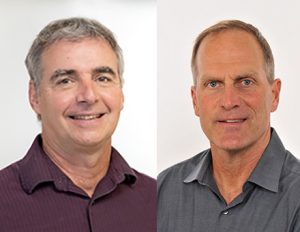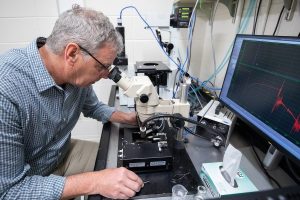By Laurel White
The two researchers were supposed to chat for just five minutes.
As their conversation moved from MRIs of human hearts and investigations of skeletal cells in mice to rare frozen tissue and even rarer expertise, those five minutes melted into hours. Years later, the duo have made discoveries that could break new ground in how heart disease is treated in people with diabetes — and they’re just getting started.

Since that first meeting in 2016, Gary Diffee, a professor in the Department of Kinesiology, and Chris Baldi, an associate professor of medicine at the University of Otago in Dunedin, New Zealand, have had quite the scientific adventure.
“This is definitely the coolest thing I’ve done for a long time in my research,” Diffee says.
Diffee and Baldi’s area of shared inquiry has to do with the unique complexities of heart disease in people with diabetes. According to the Centers for Disease Control and Prevention, people with diabetes are twice as likely to have heart disease compared to people without the condition. The two health challenges often go hand-in- hand, but research has shown that many medications used to treat heart disease aren’t as effective for people living with diabetes.
“We know very little about what diabetes is doing to the heart — why it is damaging heart function, why it’s making treatment less effective,” Diffee explains.
Baldi had been doing research on cardiac function and diabetes for a while before meeting Diffee. His research involved taking MRIs of hearts and using the images to examine how the organ reacted to things like exercise. Diffee suggested shifting the research toward a relatively rare technique he’d used for years in his own lab: examining the structure and function of single cells. Diffee argued that examining the heart in such a granular way could reap big benefits for understanding how it works, or fails to work, under certain conditions.

“Gary is one of a small number of people in the world who do this type of research,” Baldi says.
The only problem: Getting access to human heart tissue to run this sort of test isn’t simple.
Fortunately, Baldi had unique access to just what they needed — a bank of frozen heart tissue at the University of Otago.
“It’s a perfect source of heart tissue for us to do single cardiac cell measurements,” Diffee says.
The first months of their collaboration were unique. Baldi mailed frozen heart tissue for Diffee to run tests on. The tissue included samples from people with diabetes, and people without. Their hypothesis: Hearts of people with diabetes have decreased sensitivity to calcium, the stimulus that triggers contractions in heart cells.
Baldi describes their first set of results as “jaw-dropping.”
“When we ran those statistics and they confirmed our hypothesis, we couldn’t believe it,” he says.
The pair’s first publication on the subject ran in the journal Cardiovascular Research in April 2018.
But it became apparent that the journey from New Zealand to Madison was too risky for such valuable tissue.
“So we hit on this idea that I should just go down there and teach him how to do this,” Diffee recalls.
Baldi won a Catalyst Fund grant from the Royal Society of New Zealand to fund Diffee’s travel and the necessary equipment — a machine so delicate it has to sit on an air cushion. Later that year, Diffee made his first trip across the ocean.

The team, which grew to include UW–Madison alumna Angie Greenman, shifted to using more readily available heart cells from diabetic rats for further research and published more papers on their findings in 2021 and 2022. Those papers found different stages of diabetes affect cardiac calcium sensitivity differently and that exercise can increase the calcium sensitivity of heart cells in rats with diabetes.
Additional papers are in the works, as is a collaboration with University of Otago pharmacologists that has led to the early stages of a new drug that could be used to treat heart disease.
Treatments currently in use for acute heart failure, like adrenaline, work by increasing calcium movement in the heart.
A challenge with these drugs, Baldi explains, is that the movement of calcium in a cell requires a lot of oxygen — it’s asking an already overburdened organ to do something that’s pretty hard work.
“For a heart that’s failing, you’re asking it to do something too difficult,” he says. “It’s almost better to do nothing.”
The new drug, which has already received approval from the U.S. Food and Drug Administration for one condition, appears to offer a way to stimulate heartbeats without increasing calcium in the heart.
Baldi says it could someday be a game-changer for heart disease treatment.
“There are no guarantees, and we may be wrong — you usually are in science,” he says. “But what if we’re on to something?”
It’s a promising path forward, and one that never would have been possible without two researchers sitting down seven years ago for a short chat. “I just think this is one of the best things about science,” Diffee says.